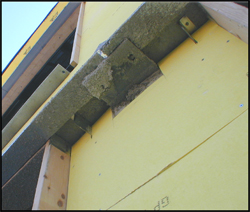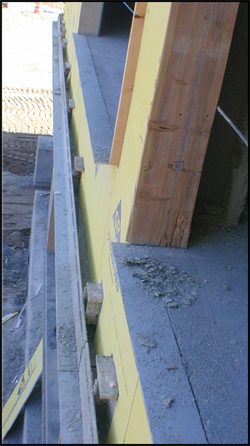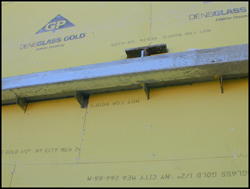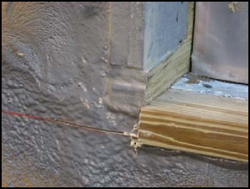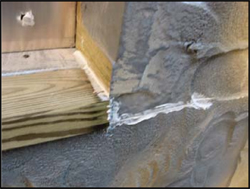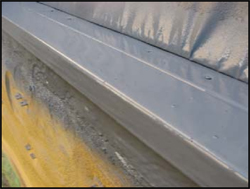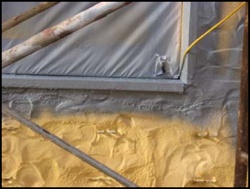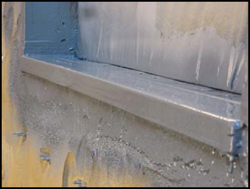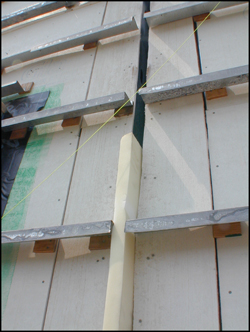|
Home
Contact Us
About FOAM-TECH
Client Services
Products
Solutions
Past Projects
Case Studies
Diagnostics & Testing
FAQ's
Building Envelope Theory
Special Environments
News
Glossary
Career Opportunities
|
 |
Back to Products Page
SUPERGREEN LAM™ (Liquid-applied Membrane)
Click here for PDF version
MSDS Request
Background of the development of SUPERGREEN LAM™
Spray-applied polyurethane foam (SPF) is fast becoming the preferred high-performance insulation system for cavity-wall construction. Historically, SPF has been used in combination with peel-and-stick membrane (aka SRAB) to provide a complete building envelope (insulation, vapor retarder, drainage plane, and air barrier) in rain screen and other exterior insulation system applications.
Building Envelope Services, Inc. (BES) began installing the SPF-A/V Barrier cavity-wall system in the US in 1994. To our knowledge, the system had only been used in Canada at that time. An installation in Burlington, VT, designed by a Canadian architectural firm, led to our first project. The performance of this system was obviously far superior when compared to interior insulation installed in typical metal-framed commercial and institutional buildings. After receiving training provided by one of the major Canadian manufacturers and successfully completing our first project, we began to promote this system here in the US.
Because this was a new technology to most architectural firms in the US, BES developed several AIA presentations introducing the approach and received approval for AIA/CES credit. The general presentation (AIA/CES 701) talks about the technical and practical reasons for using the system vs. other methods. The “Details” presentation (AIA/CES 702) addresses how to design, specify, and detail cost-effective, high-performance projects using this approach. The “Construction Phase” presentation (AIA/CES 703) addresses the construction and quality assurance protocols for this system. (See our introduction)
After installing the system for a number of years, it became clear that the peel-and-stick membranes, while performing a necessary function, were the weak link in the system. In addition to quality assurance problems, the high labor costs and seasonal weather-related limitations of these types of installations had to be addressed for this system to be a successful alternative to previously used cavity-wall systems.
This need led BES to the development of SUPERGREEN LAM™ (liquid applied membrane or LAM) in 2005. This unique material is a proprietary (patent-pending) product that has better physical properties than peel-and-stick sheet goods. It is designed to expand slightly during processing to fill or bridge gaps reliably. Most single-coat, spray-applied coatings run into cracks before they cure, leaving an incomplete air and water barrier. Peel-and-stick membranes can be effective in simple, relatively flat applications, but become more and more difficult to install as three-dimensional applications increase in complexity. Quality assurance testing indicates that these conditions are problematic when trying to achieve high-performance air and vapor barrier installations, and are not reliable when used as pan flashings and other complex, water-management applications. LAM offers efficient sequencing as it is installed at the same time as the SPF. It can be left exposed indefinitely. Peel-and-stick cannot. Installation is not hampered by cold, and installation at ambient and substrate temperatures from -20 to 300 degrees is possible. It cures rapidly, has no VOCs, and is odorless. LAM is waterproof, airtight, and exhibits low vapor transmission. It has a Class 1 fire rating.
The following outlines the problems that can occur in sheet membrane installations that must be installed on difficult substrates; on complex, structural bracket shapes; in bad weather; and that may remain exposed to the sun for months before being covered by exterior cladding and trim:
-
Lap seams must be primed, shingled, and rolled to assure a complete seal and water-shedding capabilities.
-
Lap seams are difficult to properly form and seal at inside corners and tend to be rounded, leaving openings that can leak air and water.
-
Inside three-dimensional corners are complex and require additional sealants that may not be durable. A wood stop can be added after the fact to allow the membrane to be used as a pan flashing. This will require another layer of membrane that is difficult to lap up and under the side/jamb membrane to properly shingle the installation.
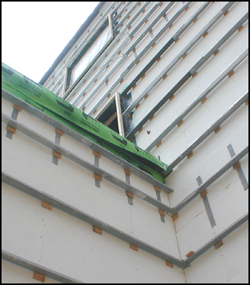
| Some membrane products will not stay fully adhered when exposed to the sun for even relatively short periods during normal construction schedules. |
|
|
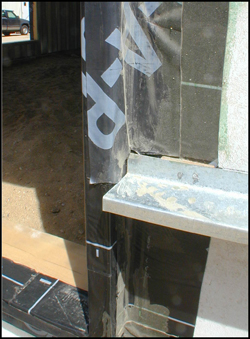
| When additional layers of membrane are required, they are often difficult to adhere. They create too much buildup in corners, often reducing shim space tolerances at windows. |
|
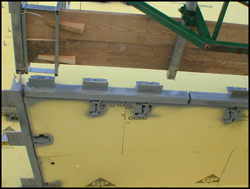 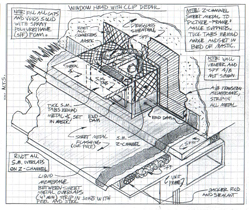 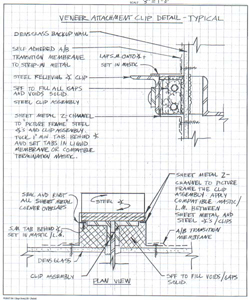
|
It is difficult and expensive to install sheet goods successfully on complex structural members like these granite cladding brackets. |
|
|
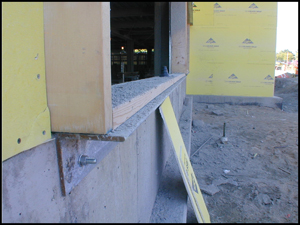
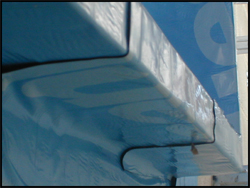
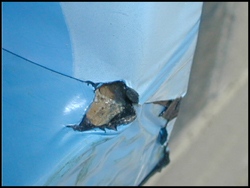
|
|
|
Complex quick turns and attachment hardware pose a significant challenge for peel-and-stick membrane installers. |
|
|
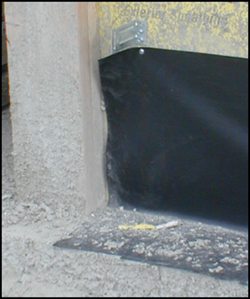
|
|
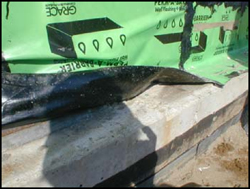
|
Membranes that are supposed to be fully adhered to substrates to avoid water and air infiltration are difficult to install on wet, dirty, and uneven substrates. Water and air can penetrate under these flashings. |
|
|
Terminations at changes in wall construction types are prone to water penetration where sheet goods end. In this detail, water can run off the end of the through-wall base flashing and under the adjacent curtain wall onto the floor beyond. |
|
|
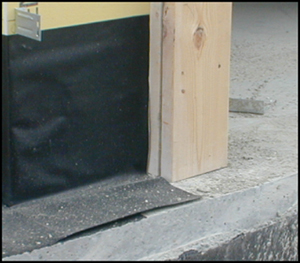
|
SUPERGREEN LAM™ easily conforms to complex shapes, and eliminates the need to make complex three-dimensional water-shedding lap seams. This allows for greatly improved productivity, thus reducing costs dramatically.
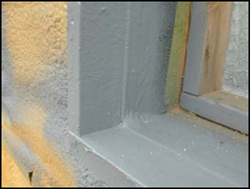
|
The bank of windows on the right would take about four man-hours to install with LAM, while peel-and-stick would require at least twenty. |
|
|
|
In this retrofit situation, peel-and-stick membrane previously installed on the inner half of this window jamb is rolled up, making a radiused corner that may interfere with the window installation. LAM makes a tight inside corner on the outer half. |
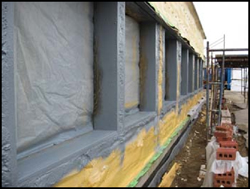
|

|
This series shows how a window opening is masked with plastic before the SPF and LAM installations. After the SPF is installed, it is trimmed flush with the face of the stops. |
|
|
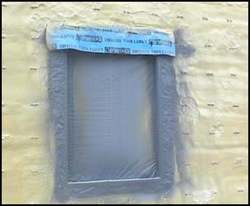
|
Finally, LAM is installed around the opening to provide a continuous air and water barrier from the SPF to the inside of the window location on the jamb stops. |
|
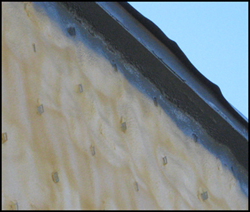
|
|
|
Transition from an SPF cavity-wall system to a roof overhang. |
|
|
|
|
|
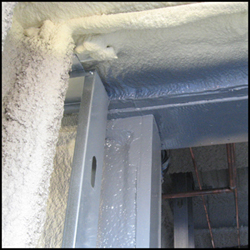
|
Complex window head at insulated overhang. |

|
Example of complex window sill location. |
|
|
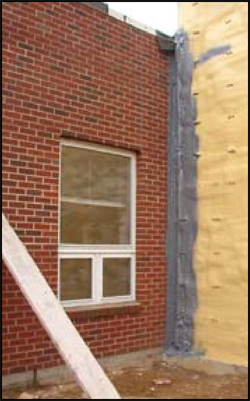
|
LAM allows air and watertight connections to difficult substrates at this expansion joint that occurs where a school addition meets existing brick construction. |
|
One of the advantages of LAM is that it can be easily repaired. Surface applications bond well to original LAM surfaces, maintaining drainage plane and A/V barrier continuity.
LAM is a tough, durable coating that is flexible and stronger than peel-and-stick membranes. It can be left exposed indefinitely, often being used as a complete finish for roofs and process equipment. Installation is not hampered by cold – installations are possible at ambient and substrate temperatures from –20F to 300F degrees. It cures rapidly, has no VOCs, and is odorless. SUPERGREEN LAM™ is waterproof, airtight, and exhibits very low vapor transmission properties. It has a Class 1 fire rating.
|
|
|
|
These above-ground storage tanks contain fuel oil that must be maintained at 120 degrees in order for the fuel to be pumped to the boilers inside the adjacent building. The tanks were insulated with 6" of SPF to conserve energy and then coated with SUPERGREEN LAM to protect the foam from the elements. |
|
|
 |
|
|
|
Technical and Material Comparisons
Physical properties:
- In-place thickness: 30 to 60 mils
- Tensile Strength: 600 to 4,200 psi
- Elongation: 450 to 600%
- Tack free: 1 – 3 minutes
- Initial cure: 60 minutes
- Full cure: 1 – 7 days
Advantages vs. peel-and-stick membranes:
- Lower cost.
- Efficient sequencing – installed at the same time as the SPF, not between the backup wall sheathing and the brick ties.
- Fast and reliable installation. No seams to prime and roll down. Expanding product allows the material to continuously cover uneven substrates and fill and bridge gaps like membrane, but in a faster, one-step process.
- Can be left exposed indefinitely (peel-and-stick cannot).
- Year-round installation. Can be effectively installed at ambient and substrate temperatures from -20 to 300 F.
- Easy to repair by recoating with large-scale production or small-scale portable equipment.
- Can be used to protect open-cell (soft) foam to create fast and effective expansion, control, and deflection joints in the SPF or other cavity-wall systems.
General Advantages:
- Rapid cure, no VOCs, odorless.
- High abrasion resistance.
- Available in both bulk and touch-up size systems.
- Waterproof, airtight, and low vapor transmission.
- Easy to detail and specify.
- Class 1 fire rating.
Expansion Joint using soft foam and SUPERGREEN LAM™
Vertical and horizontal expansion joints are required in large structures to allow for movement due to changes in temperature and structural loading. The following horizontal sections show how the LAM detail provides complete freedom of movement, even across the spray-applied polyurethane foam (SPF) insulation system.
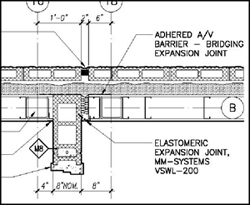 |
|
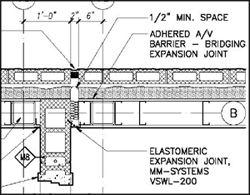 |
|
The original detail allows movement in all of the building materials except the SPF. |
|
|
|
The new detail includes a gap in the SPF insulation and A/V Barrier system to allow complete unrestrained movement across all of the materials. A flexible foam strip provides a placeholder along the line of the anticipated building movement, as well as some insulation value. The LAM coating protects the soft foam from water infiltration and UV degradation. It also provides a flexible but impermeable connection across the gap in the SPF to maintain a continuous air, vapor, and water barrier. |
|
|
|
|
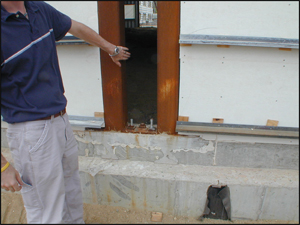
|
Structural steel columns on either side of the location of an expansion joint. |
|
|
|
|
|
First, the flexible foam strip is placed in the gap in the structure along the line of the expansion joint. |
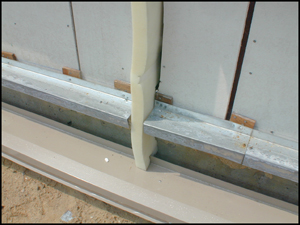
|
|
|
Next, polyurethane foam (SPF) is sprayed on both sides of the flexible foam. Some trimming may be required. |
|
|
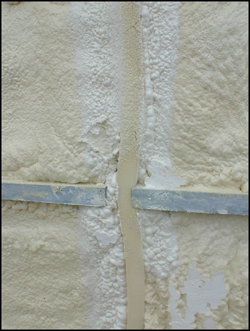 |
|
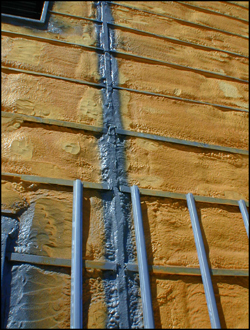
|
|
|
Finally, the flexible foam is coated with SUPERGREEN LAM™ to complete the air/vapor barrier and the drainage plane. |
|
|
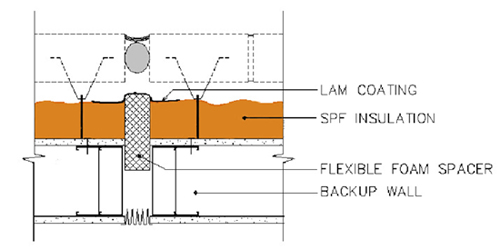
|
|
Horizontal Section through an SPF/LAM expansion joint showing a 2" flexible foam spacer with SPF on both sides. |
|
|
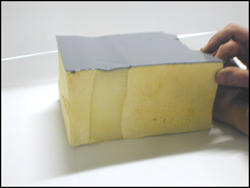
|
|
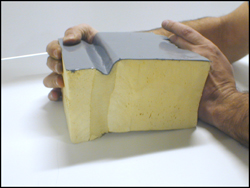
|
|
Section of a sample cut from an actual SPF/LAM expansion joint showing a 2" flexible foam spacer with SPF on both sides. |
|
|
|
Section of a sample cut from an actual SPF/LAM expansion joint showing the flexible foam spacer compressed to 1" as it would be during building movement. |
|
Related Information:
Back to Products Page
|










